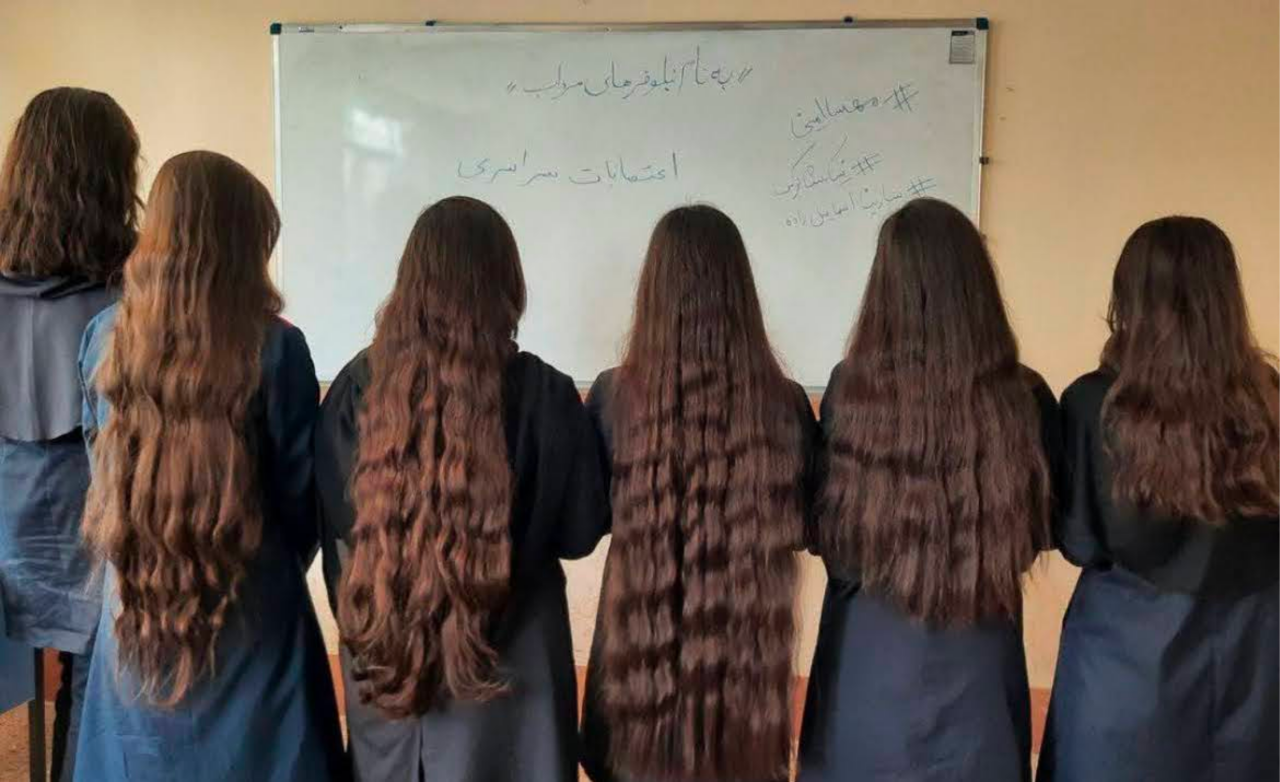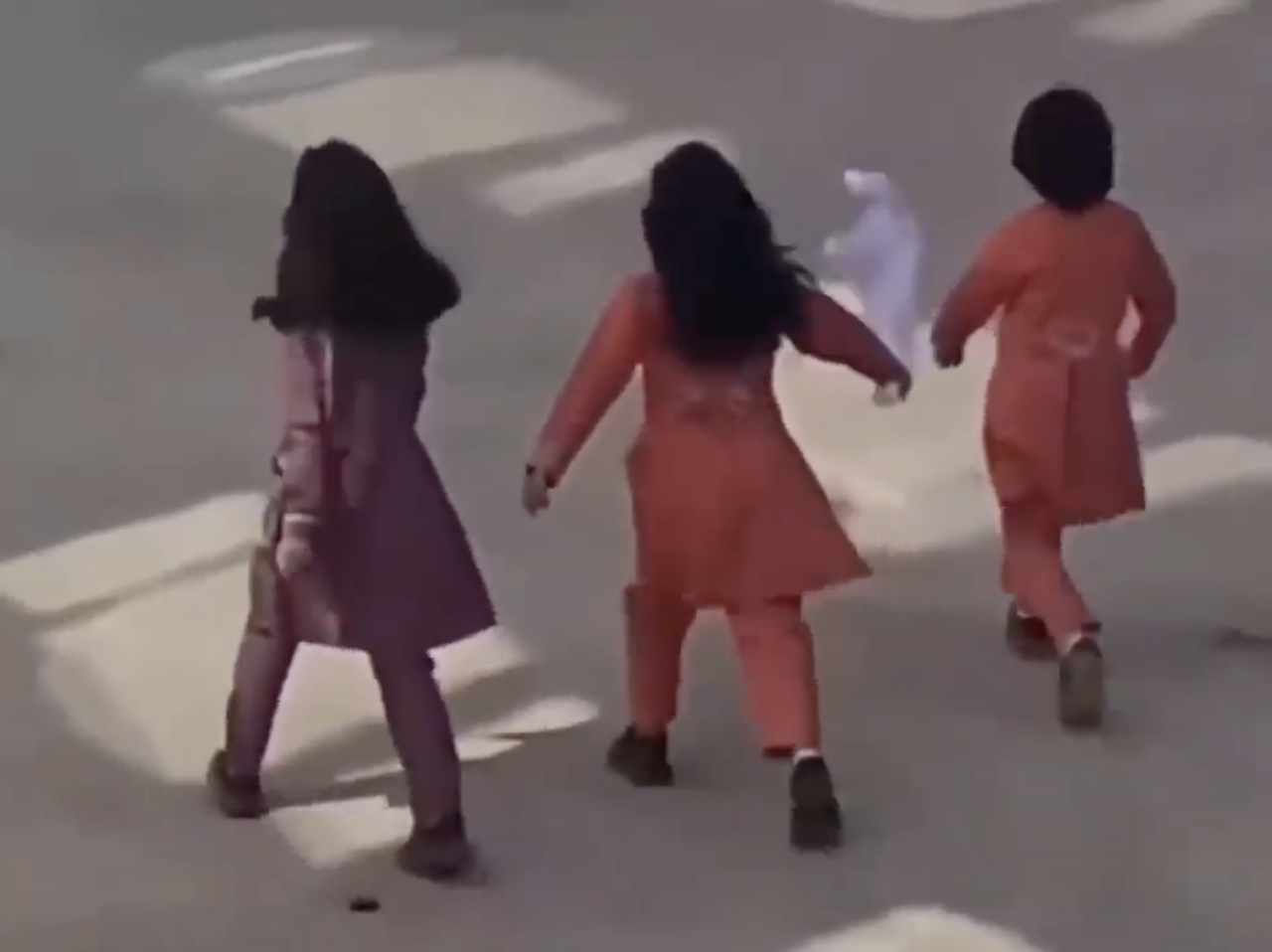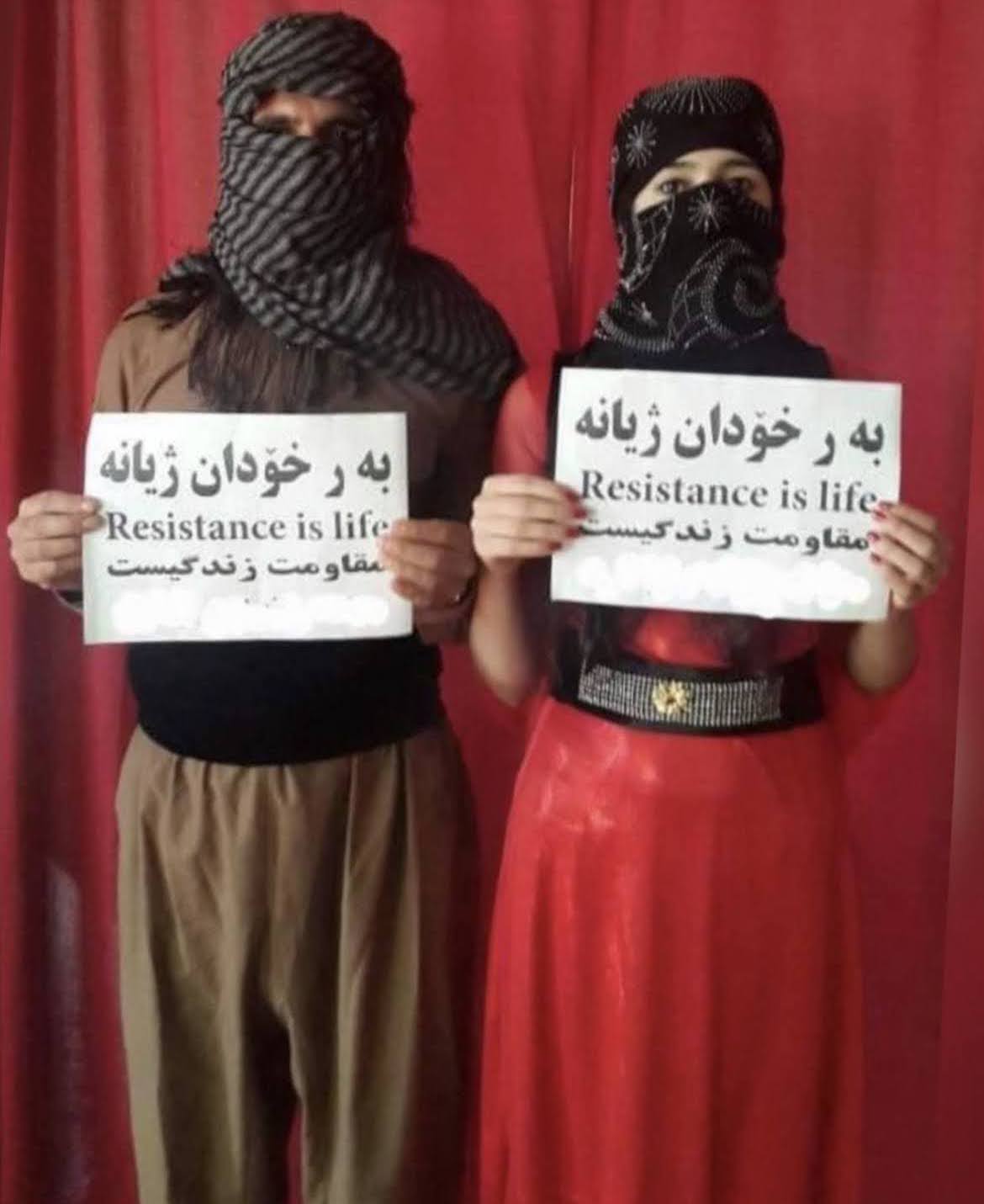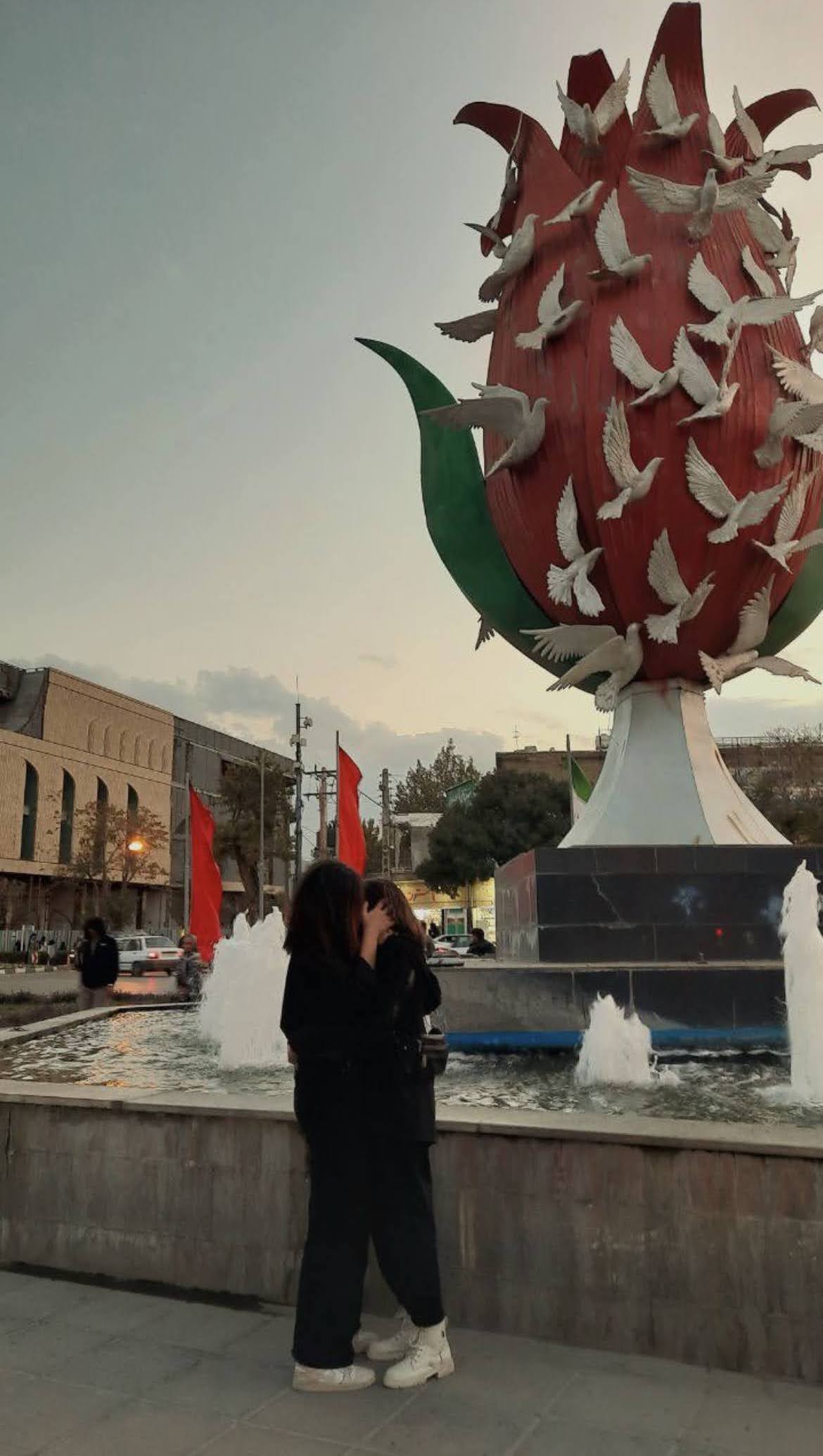Special to Feed by Cassie Packard, Eyebeam Oral Historian
Note to readers: Cassie Packard spoke with five out of eight members of the collective. In order to protect their anonymity, responses have been labeled 1, 2, 3, 4, and 5.



Eyebeam Democracy Machine Fellow Group 2024, Begoo Collective’s logo. Courtesy of the artists.*
Special to Feed by Cassie Packard, Eyebeam Oral Historian
Note to readers: Cassie Packard spoke with five out of eight members of the collective. In order to protect their anonymity, responses have been labeled 1, 2, 3, 4, and 5.
Anonymous #1: When the uprising started, it shook all of us, considering that we [Begoo Collective members] were all born after the Stolen Revolution [1977–79] and grew up under mandatory Islamic laws. So, to see the images of the uprising coming out of Iran on social media, in which women were walking around without hijab, burning their headscarves, and enacting other forms of resistance, felt profoundly radical to our lifetime. We were all constantly checking our phones, to stay updated with the news and to post and share it with others. After a while, I started feeling lonely in posting and trying to get this urgent news out, it felt as if I was shoveling the ground by myself while I could see another person shoveling over there, and another over there, and I felt urgently that we needed to do this together. I reached out to a few people I saw posting on social media, and each person also reached out to a person they knew, and gradually, the group formed itself. It didn’t start with a specific project; it was more a place where we could meet and ask “What’s going on in your world? How do you feel about this? What do you see for the future?” But as we continued to meet regularly, we started to wonder how we could put our energies together. We spoke about our concerns and what was important to us, and then defined projects, where everyone picked up part of the job.
Anonymous #2: Once I got the message to meet up virtually, I said yes immediately. I had been waiting for an invitation to come together with fellow Iranians. Several of us had emigrated around the same time so we had that shared experience. Coming together helped to actualize our pain, our grief, and our lived experience. In the group, I didn’t have to explain why what was happening was important; we had a shared understanding of the gravity of the moment, and in our bodies, we felt how historic and liberating it was. The projects organically came out of these conversations and collectively thinking about how we can contribute to this moment. Being away from Iran gave us a certain level of freedom to do what we wanted to do, though it was very difficult to be away and witness everything through a screen. At the same time, we were coming together through the screen, to find ways to contribute to the uprising.
Anonymous #3: One of our members was in Iran at the time, though she isn’t now. Most of us traveled to Iran the summer after the uprisings started, so some of us got to see it firsthand. But a lot of what traumatized us came through screens, and we needed a space to reflect on it. What you said is important, that screens also helped us process and heal together; we’ve been meeting virtually regularly.
Anonymous #4: The screen allowed us to gather from many different locations, so in that sense it was a mediator or a bridge. There was so much material coming out of Iran; I think we were all glued to our phones and screens for at least a year. I remember a similar feeling, though not as intense as this time, during the Iranian Green Movement [2009–10], which marked the first time that social media really became a space for movement-building and organizing in the country. There has been an interesting connection between people in Iran and outside of Iran, in that people on the ground say, “If your internet is working and you can share things, please work with us to amplify what’s happening.” There are complicated relationships between these physical and digital notions of building spaces and coming together.
Anonymous #3: The idea to create an archive of images of the uprising came out of realizing that we had never seen these kinds of gestures of defiance. We felt like it was our responsibility to hold space for these images and videos, and to ensure that they’re not forgotten. The reality is that anyone in Iran who has taken these images or posts them has to immediately delete them off their phone so they don’t get in trouble if they get arrested, so most people inside of the country don’t have access to them except for on social media—and on social media, once something’s in the past, it can be hard to access it. What we are hoping to do with our archive project [Figuring a Womxn’s Revolution: An Archive] is to give these images a more permanent, consolidated, centralized place to exist. Right now, if you’re looking for a specific image of the uprising that you saw a year ago, it’s almost impossible to find it; it just lives in your head. We want to use the privilege of having our bodies in this different context to give people in Iran access to these images and to make sure there is a permanent record of this uprising for the world to see.

Courtesy of Begoo Collective. Archival Images for the project, ‘Figuring a Womxn’s Revolution: An Archive,’ are taken from various social media platforms following the 2022-2023 Woman Life Freedom uprising in Iran.

Courtesy of Begoo Collective. Archival Images for the project, ‘Figuring a Womxn’s Revolution: An Archive,’ are taken from various social media platforms following the 2022-2023 Woman Life Freedom uprising in Iran.
Anonymous #5: When I joined the group, digital archives were already a big part of my practice and research. In a world where archives are frequently imperialist and orientalist, we need alternative archives that can work against these dominant patterns and create space for people who are marginalized, silenced, or erased from history. Creating this digital archive as an alternative form of knowledge production with the Begoo Collective is not just a practice of collecting images; it’s also about organizing them, labeling them, and showing that what we have witnessed from a distance over the past years can create a commitment to justice and collective healing. I believe that archiving can be a form of resistance; we’re making a space that works against forgetting, remembering the past while connecting it to the future.
Anonymous #4: In my own work, I’ve done a lot of archiving projects and thought about the decolonizing aspect of archival practices. In the context of the history of feminist movements, there is a limited amount of documentation of or archival work on feminist movements in Iran; one of the few pieces of documentation of the 1979 Iranian feminist movement was a film by French feminists. Iranian feminism and Global South feminism often end up being documented through this Western lens, and documenting and archiving through our own lens is a way of turning around those power structures and taking ownership of these spaces.
Anonymous #2: In the images coming out of Iran, we saw these embodied female gestures in a way we had never seen before, as women and girls burned their scarves or posed on top of a police car on fire. These photos, which people were risking their lives to make, demanded to be shared and archived as a way to create memories or think about the future collectively.
Anonymous #3: To build on that, there was a great text that came out from L in Iran [https://www.e-flux.com/notes/497512/women-reflected-in-their-own-history], on the importance of gestures, that framed how we thought about this archive and how we thought about the revolution. The images are so performative because these women are performing in front of a camera for an audience to encourage someone else to go outside and do the same. They’re paying a price for posing on top of a police car on fire, of course. Something that L also writes about is figuring out new and rhizomatic situations: gathering to put your scarves on fire in one place and then getting out to go create a situation somewhere else. The revolution was both gestural and situation-based, and because of that, and the lack of centralization, there was a lot more capacity for resistance. Our archive is structured around the woman’s body and its capacity for creating these gestures of resistance.
Anonymous #1: There was a lot of creativity around creating images of resistance while retaining anonymity, too. We saw images of women from the back, or girls’ feet stepping on pictures of authority figures. People sent balloons in the air that said Zan Zendegi Azadi [Women, Life, Freedom] on them. These balloons would hover over the city; you didn’t need to know where they came from, but they were there, taking up space.
![An archived image taken from an anonymous social media source. A photo aimed up at the near-dusk light blue to yellow-orange sky, are balloons in Red, White, and Green, holding a banner that says Zan Zendegi Azadi [Women, Life, Freedom] in farsi.](https://eyebeam.org/wp-content/uploads/post//Baloons_holding_woman_life_freedom.png)
Courtesy of Begoo Collective. Archival Images for the project, ‘Figuring a Womxn’s Revolution: An Archive,’ are taken from various social media platforms following the 2022-2023 Woman Life Freedom uprising in Iran.
Anonymous #4: Those two keywords are things we’ve discussed a lot. I’ll start with solidarity. Our gathering grew out of this feeling that there was a lack of solidarity from international movement organizers, including feminists. For the first four or five months of the revolution, especially, Western feminist movements were silent, much to our shock. We spoke about our feelings of isolation and how we couldn’t feel solidarity from these places, or saw their solidarity as just some words that didn’t really mean anything. We asked: What would it mean to actually experience solidarity, or give solidarity beyond words? What is action-based solidarity? There’s a great quote from the Senegalese filmmaker Sembène Ousmane, who says that instead of being a sunflower and looking toward the sun, what would it mean to be the sun yourselves? With the gathering of our group, instead of looking out and hoping for solidarity from an international scene, we built our own solidarity and the spaces we actually need. We felt our goals and hopes for this collective were closest to ideas of transnational feminism.
Anonymous #3: When you asked the question, the first thing that came to mind was that we’re on a quest to figure that out. What does it mean to have solidarity or transnational feminism? I don’t think we have an answer, but we’re inching toward something. We have had conversations with our sisters from other Iranian collectives and feminist collectives around the world, specifically from the Global South about this topic. We’re always thinking about these issues on a global scale and how underlying systems of oppression are woven into one another. We believe that no one is free until we are all free.
Anonymous #2: What came up for me is that solidarity is bearing witness and offering compassion. It was disheartening to witness that the struggle in Iran was not understood as part of a much bigger issue; at the same time in the US, we were experiencing an abortion ban, and people couldn’t seem to connect the dots that there was a global attack on women’s bodies. Solidarity is connecting the dots between these different oppressive forces. It’s worth noting that the movement’s slogan, Woman Life Freedom, is a Kurdish slogan, so voices from a marginalized and oppressed ethnic group were being centered.

Courtesy of Begoo Collective. Archival Images for the project, ‘Figuring a Womxn’s Revolution: An Archive,’ are taken from various social media platforms following the 2022-2023 Woman Life Freedom uprising in Iran.
Anonymous #1: Forces like capitalism and patriarchy try to prevent us from feeling that we’re interconnected, that our pain is related. There’s this misconception that if you’re fighting climate change, that’s different from women’s oppression, that’s different from the war that is happening, that’s different from animal rights. This was one of our key realizations: these are all pouring into the same bowl, and understanding how to find the connections is crucial. When we connect with our Afghan or Palestinian sisters, we’re thinking about how we can understand the overlaps between our situations, to push against feelings of separation and isolation and toward collective liberation.

Courtesy of Begoo Collective. Archival Images for the project, ‘Figuring a Womxn’s Revolution: An Archive,’ are taken from various social media platforms following the 2022-2023 Woman Life Freedom uprising in Iran.
Anonymous #4: This is part of the reason we’re so excited to be part of the community with Eyebeam, too. This relates to building points of connection with existing communities and purposefully putting our energies together and empowering one another—to becoming the sun.
* The collective’s logo design of the word Begoo is repeated three times, each paired with one word from the “Woman Life Freedom” slogan. The stylization of the words Woman, Life, and Freedom, are meant to resemble both long hair blowing in the wind and flame tongues –a reference to Iranian women setting their scarves on fire, symbolizing both the liberation of hair and freedom of the body. The logo is translated into English as “Say Woman, Say Life, Say Freedom,” which is often used in protest chants in Iran.